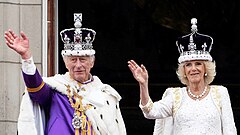
Back تتويج تشارلز الثالث Arabic تتويج ديال تشارلز التالت ARY Coronació de Carles III i Camil·la Catalan Korunovace Karla III. a Camilly Czech Coroni'r Brenin Siarl III a'r Frenhines Camilla Welsh Kroning af Charles III og Camilla Danish Krönung von Charles III. German Στέψη του Καρόλου Γ΄ και της Καμίλα Σαντ Greek Coronación de Carlos III del Reino Unido y Camila Spanish تاجگذاری چارلز سوم و کامیلا Persian
 The King and Queen waving from the balcony of Buckingham Palace following the coronation service | |
| Date | 6 May 2023 |
|---|---|
| Location | Westminster Abbey |
| Participants |
|
The coronation of Charles III and his wife, Camilla, as king and queen of the United Kingdom and the other Commonwealth realms, took place on Saturday, 6 May 2023 at Westminster Abbey. Charles acceded to the throne on 8 September 2022 upon the death of his mother, Elizabeth II. It was the first coronation held since Elizabeth II's coronation in 1953, nearly 70 years prior.
The ceremony was structured around an Anglican service of Holy Communion. It included Charles taking an oath, being anointed with holy oil, and receiving the coronation regalia, emphasising his spiritual role and secular responsibilities.[a] Representatives of the Church of England and the British royal family declared their allegiance to him, and people throughout the Commonwealth realms were invited to do so. Camilla was crowned in a shorter and simpler ceremony. After the service, members of the royal family travelled to Buckingham Palace in a state procession and appeared on the palace's rear and front balconies. Several changes were made from past coronations, including a shorter runtime when compared to Elizabeth II's and alterations to reflect the United Kingdom's multiple faiths, cultures, and communities. The event reached a peak television audience of 20.4 million in the UK, making it the country's most-watched broadcast of 2023. Globally, it attracted an audience of two billion people across 125 countries.
The coronation elicited both celebrations and protest in the United Kingdom, with surveys carried out before the event suggesting that the British public was ambivalent towards the ceremony and its funding by taxpayers. The events in London and Windsor drew large crowds, but were also protested against by republican groups; 64 individuals were arrested on the day, which was criticised by the international advocacy group Human Rights Watch. The celebrations included street parties, volunteering, special commemorative church services, and a concert at Windsor Castle on 7 May. The response in the other Commonwealth realms was similarly mixed; while there were many celebrations, some government officials and indigenous groups took the opportunity to voice republican sentiments and call for reparatory justice. It was the first British coronation in the 21st century and the 40th to be held at Westminster Abbey since the coronation of William the Conqueror in 1066.[b]
Cite error: There are <ref group=lower-alpha> tags or {{efn}} templates on this page, but the references will not show without a {{reflist|group=lower-alpha}} template or {{notelist}} template (see the help page).
- ^ Gosling, Lucinda (2013). Royal Coronations. Oxford: Shire. p. 7. ISBN 978-0-74781-220-3.